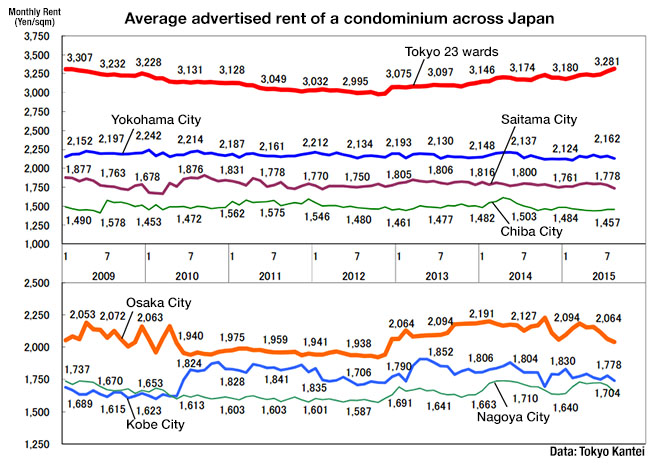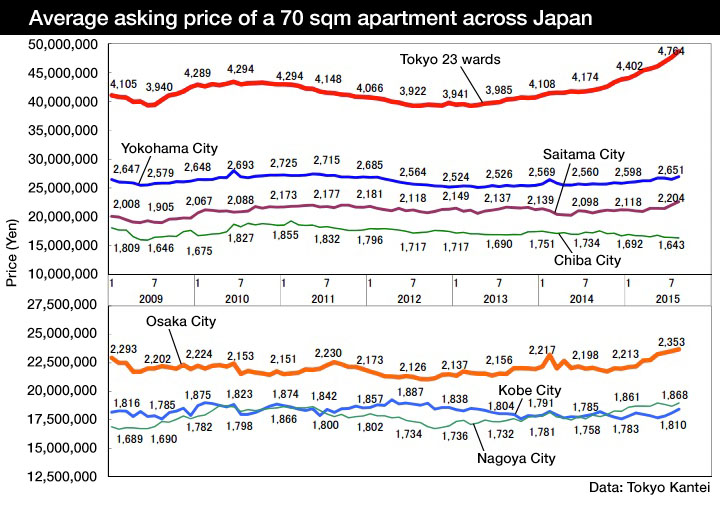Ota-ku may relax short-term accommodation regulations
Tokyo’s Ota Ward has announced plans to relax accommodation regulations in order to provide accommodation for the growing number of foreign tourists in the lead up to the 2020 Tokyo Olympics. It is expected that the new rules may go into effect by the end of this year.
Hotels in Ota Ward are currently operating with occupancy rates of over 90%, and there are concerns of a shortage in accommodation options for visitors.Read more
Chinese developer sets sights on Japanese real estate market
Chinese developer, Greenland Group, is planning to invest in Japan’s real estate market. On September 21, Mizuho Financial Group entered into a business partnership with the developer. As part of the agreement, Mizuho will provide support and assistance for Greenland’s investments in Japan.Read more
Central Tokyo apartment asking prices up 16.6%
According to Tokyo Kantei, the average asking price of a 70 sqm (753 sq.ft) second-hand apartment in greater Tokyo in August was 31,150,000 Yen, up 1.5% from the previous month and up 10.7% from last year. This is the 12th month in a row to see an increase. The average building age was 22.2 years.
In Tokyo’s 23 wards, the average asking price was 48,660,000 Yen, up 2.1% from the previous month and up 16.1% from last year. This is the 14th month in a row to see an increase. The average building age was 22.2 years.
Price growth in central Tokyo continues to show no sign of slowing, with the average price in central Tokyo’s six wards reaching 68,290,000 Yen, up 2.0% from the previous month and up 16.6% from last year. This is an increase of 33.9% from the most recent market bottom of October 2012, when the average price was 50,990,000 Yen. The average building age was 21.0 years.
Kyoto machiya popular with foreign buyers
 According to the Urban Research Institute Corporation, foreign corporations acquired 1.2 billion Yen of real estate in Japan in 2014, 2.8 times higher than the figure in 2013. This accounted for a little over 20% of the value of all transactions nationwide.
According to the Urban Research Institute Corporation, foreign corporations acquired 1.2 billion Yen of real estate in Japan in 2014, 2.8 times higher than the figure in 2013. This accounted for a little over 20% of the value of all transactions nationwide.
While most of the foreign investment is centred in Tokyo, Kyoto is also attracting some foreign buyers.Read more
Owners association wins lawsuit against sharehouse operator
 The owner of a share house that has been operating out of a condominium building in Arakawa-ku, Tokyo, has been ordered by the Tokyo District Court to remove the interior partition walls that had been installed to create small share rooms.
The owner of a share house that has been operating out of a condominium building in Arakawa-ku, Tokyo, has been ordered by the Tokyo District Court to remove the interior partition walls that had been installed to create small share rooms.
The share house was a violation of the building’s management bylaws. The owners’ association filed a suit against the apartment owner, and the Tokyo District Court ruled in favour of the plaintiffs on September 18. The judge noted that the use of the apartment exceeded what was expected for a normal residential unit.Read more
Renewal of modernist theatre in Kyoto reaches completion

Construction and refurbishment of the 55-year old Kyoto Kaikan building finished earlier this month. The original hall was designed by leading modernist architect Kunio Maekawa (1905-1986) and built in 1960. However, theatre stages were too small and the building was not equipped for operas or ballet performances. The building’s condition was also starting to deteriorate.
Kyoto City spent 11 billion Yen refurbishing the South Hall which included preserving the Maekawa-designed exterior, while the Main Hall was completely rebuilt into a 6-storey hall with 2,005 seats.Read more
Average rents up in Tokyo, down everywhere else

According to Tokyo Kantei, the average monthly rent of a condominium in greater Tokyo was 2,590 Yen/sqm in August, showing no change from the previous month but up 1.1% from last year. The average apartment size was 60.61 sqm and the average building age was 19.5 years.
In the Tokyo metropolitan area, the average rent was 3,177 Yen/sqm, up 1.0% from the previous month and up 4.5% from last year. The average apartment size was 57.68 sqm and the average building age was 17.5 years.
Average rents in Kanagawa, Saitama, greater Osaka, Hyogo and Aichi were down from last year.
In Tokyo’s 23 wards, the average rent was 3,314 Yen/sqm, up 1.0% from the previous month and up 4.7% from last year. The average apartment size was 57.13 sqm and the average building age was 17.0 years. Yokohama, Saitama City, Chiba City, Osaka City, Kobe City and Nagoya City all saw average rents fall from last year. Osaka City saw the biggest fall in rent with the average falling 5.5% from last year to 2,040 Yen/sqm.Read more

